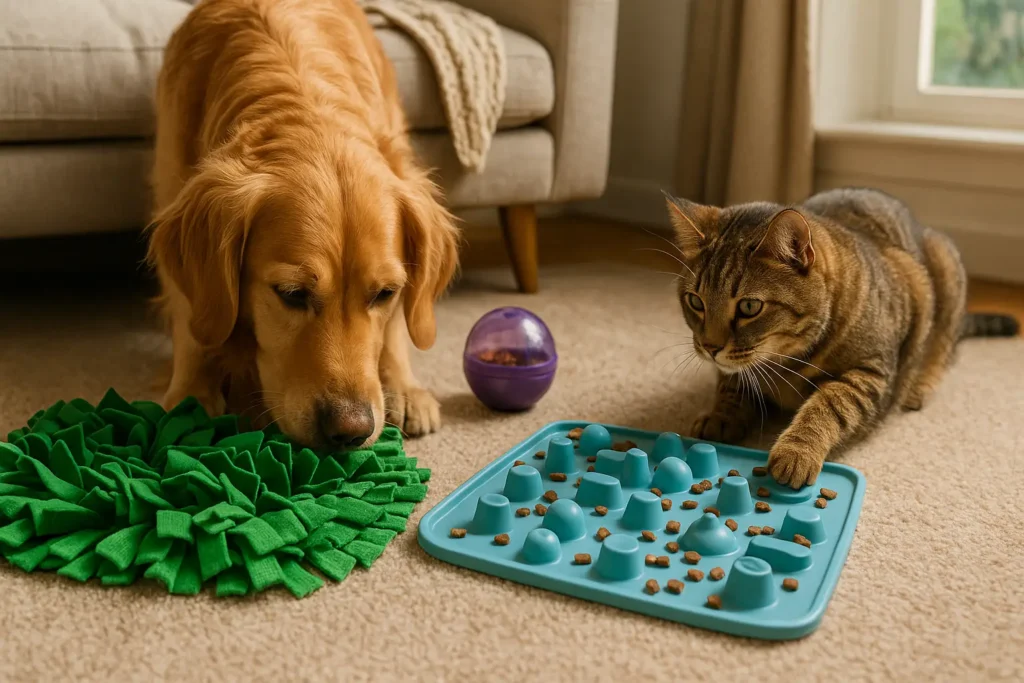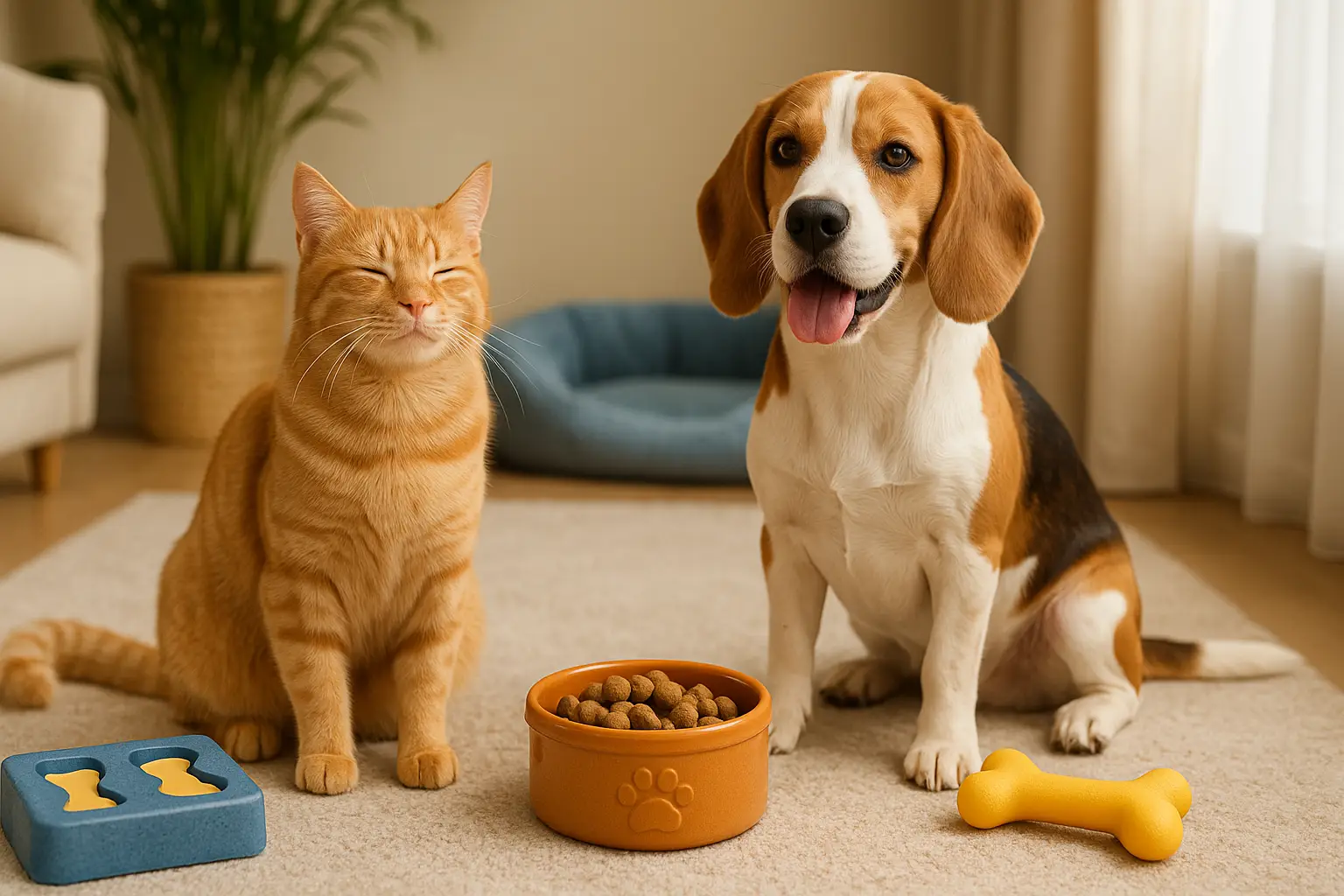How to Prevent Boredom in Pets at Home
Boredom isn’t just a human problem—pets experience it too. When dogs or cats lack stimulation, they don’t just sit quietly waiting for something to happen. They act out, shut down, or find their own (often destructive) ways to entertain themselves. From shredded furniture to endless barking, behavioral issues often stem from a single root cause: boredom.
But the solution goes beyond toys and treats. Preventing boredom in pets means understanding their natural instincts and creating a home environment that keeps them physically, mentally, and emotionally engaged.
This in-depth guide offers everything you need to keep your furry companion active and fulfilled—regardless of your schedule, home size, or lifestyle.

Why Pets Get Bored
Pets are intelligent, social, and curious creatures. In the wild or even on working farms, animals are constantly solving problems, exploring new areas, and engaging their senses. But in domestic life, especially indoor-only settings, much of that natural stimulation is missing.
Common Causes of Boredom in Pets:
- Lack of physical exercise
- Monotonous routines
- No opportunities for exploration or problem-solving
- Isolation or lack of interaction
- Insufficient mental stimulation
- Underuse of natural instincts (hunting, sniffing, digging, climbing)
Understanding these causes is the first step to building a better, boredom-free life for your pet.
How Boredom Affects Behavior
Bored pets often express their frustration in ways that humans misinterpret as “bad behavior.”
Signs of Boredom in Dogs:
- Excessive barking or whining
- Chewing furniture or personal items
- Digging indoors or outside
- Jumping on people or hyperactivity
- Escaping or running away
- Repetitive pacing or licking
Signs of Boredom in Cats:
- Scratching furniture
- Overgrooming or pulling fur
- Zoomies at night
- Attacking ankles or other pets
- Constant meowing or yowling
- Sleeping excessively due to under-stimulation
Boredom is a form of emotional distress. And the good news? It’s 100% preventable with the right routine.
Step 1: Rotate Toys and Activities Regularly
Just like people, pets get bored with the same activities every day.
Toy Rotation Tips:
- Keep 5–7 toys available at a time
- Swap them out weekly to create novelty
- Use different types: chew toys, squeakers, puzzle toys, plush, ropes
- Store unused toys in a sealed container with catnip or treats for extra excitement later
Cats enjoy chasing and pouncing toys. Dogs love items they can tug, fetch, or dissect. Rotating toys mimics the variety they’d find in nature.
Step 2: Schedule Interactive Playtime
Dedicated playtime isn’t optional—it’s essential. Even 15 minutes twice a day can prevent boredom in pets.
For Dogs:
- Tug-of-war
- Fetch with a soft indoor ball
- Hide-and-seek (with people or toys)
- Scent games using treats under cups
For Cats:
- Feather wand or fishing-pole style toys
- Laser pointer (end session with real toy “catch”)
- Crinkly paper, tunnels, or cardboard boxes
- Puzzle balls or treat mazes
Stay present and engaged. Your energy enhances the experience.
Step 3: Offer Mental Challenges Through Enrichment
Mental exercise is just as important as physical activity.
Enrichment Ideas:
- Puzzle feeders
- Frozen KONGs with treats or peanut butter
- Snuffle mats or scatter-feeding
- DIY treasure hunts using kibble or toys
- Obstacle courses made with household items
Cats benefit from vertical enrichment like climbing shelves, window perches, and new hiding spots.
Step 4: Use Training as Play
Training builds skills, boosts confidence, and strengthens your bond—all while banishing boredom.
Start with basics:
- Sit, stay, come, down (dogs)
- Touch, high-five, or jump through hoops (cats with clicker training)
Use positive reinforcement and keep sessions short and upbeat. You can train during commercial breaks or before mealtimes for added motivation.
Step 5: Encourage Natural Behaviors
Dogs and cats are born with instinctual needs: to sniff, chase, dig, climb, or stalk. Domestic life often restricts these behaviors—but you can recreate them indoors.
For Dogs:
- Scatter dry food on a rug or in the grass
- Use cardboard boxes for digging games
- Let them sniff on walks without rushing
For Cats:
- Provide boxes, tunnels, and paper bags
- Allow stalking play with wand toys
- Give access to window views or birds on screen
Letting pets act like pets is one of the best ways to keep them emotionally satisfied.
Step 6: Create a Sensory-Rich Environment
A stimulating home environment can make a huge difference—especially when you’re away.
Sensory Ideas:
- Play nature sounds or calm music
- Add bird feeders outside windows
- Rotate furniture or rearrange toys
- Use scent-based toys or pet-safe diffusers
- Introduce new textures: blankets, scratchers, or rugs
Cats and dogs love novelty—but it needs to be introduced slowly. Too much change can overwhelm instead of excite.
Step 7: Provide Solo Entertainment for Alone Time
Even if you work all day, your pet doesn’t have to be bored.
Tools to help:
- Interactive treat dispensers
- Pet-safe chew toys (bully sticks, nylon bones, etc.)
- TV for pets (available on YouTube or streaming)
- Window perches with outdoor views
- Automatic laser toys or rolling balls (for cats)
If possible, check in remotely via pet cameras, or leave a voice message using smart home devices.
Step 8: Establish a Daily Boredom-Busting Routine
Structure keeps pets calm and gives them something to anticipate.
Example Schedule:
| Time | Activity |
|---|---|
| 7:00 AM | Breakfast and short walk/play |
| 9:00 AM | Chew toy or food puzzle |
| 12:00 PM | Scent game or solo enrichment |
| 3:00 PM | Snuggle time or brushing |
| 6:00 PM | Training session + dinner |
| 8:00 PM | Wand toy play or tug-of-war |
| 10:00 PM | Wind-down cuddle and soft music |
Repeating core elements daily builds emotional security and prevents aimlessness.
Step 9: Socialize (Carefully and Safely)
Some pets enjoy playdates or social outings.
Tips:
- Invite calm, compatible pets for supervised indoor visits
- Visit pet-friendly cafes or stores (for dogs)
- Arrange safe viewing spots to observe other animals or people
- Never force interaction—observe for stress signals
For cats, even watching birds or squirrels is social enrichment.
Step 10: Use Mealtime for More Than Food
Feeding time is another opportunity for engagement.
Ideas:
- Use mealtime for training rewards
- Feed from puzzle toys or snuffle mats
- Hide meals in different locations
- Turn dinner into a “hunt” with multiple small bowls
This transforms passive eating into active engagement—especially important for indoor cats.
Step 11: Consider Pet-Safe DIY Projects
You don’t need expensive tools to keep your pet entertained.
DIY Enrichment:
- Paper towel rolls stuffed with treats
- Ice cubes with bits of chicken or tuna
- Muffin tin with tennis balls hiding snacks
- Toilet paper boxes as cat caves or tunnels
Always supervise new materials and remove them if chewed or damaged.
Step 12: Observe and Adapt
No two pets are the same. What excites one may bore another.
Watch for:
- Tail wagging or purring
- Ears perked up or focused gaze
- Following you for more play
- Quick learning during training sessions
If your pet loses interest in an activity, change the timing, location, or type of toy. Variety and responsiveness keep boredom at bay.
Step 13: Avoid Overstimulation
Too much stimulation can overwhelm pets, especially seniors or anxious types.
Tips:
- Use short sessions (10–15 minutes)
- Let your pet choose when to engage
- Watch for stress signs: panting, yawning, hiding
- Always offer downtime between active play
Balance excitement with rest for long-term well-being.
Step 14: Include Your Pet in Your Life
Engagement doesn’t always mean active play. Pets love passive companionship too.
Ways to include them:
- Sit on the floor during phone calls or reading
- Let them lie at your feet during remote work
- Talk while doing chores
- Offer a perch near a window you sit by
Being nearby, even during your “quiet” time, prevents isolation-based boredom.
Final Thoughts: A Stimulated Pet Is a Happy Pet
You don’t need to spend hours each day entertaining your dog or cat. But you do need to be intentional.
By rotating toys, offering daily enrichment, building structure, and honoring your pet’s instincts, you create an environment where boredom fades and joy thrives.
Preventing boredom in pets isn’t just about distraction—it’s about giving them a life that feels rich, exciting, and full of purpose. And that’s something every animal deserves.




Post Comment